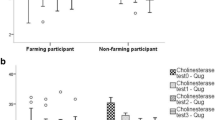Abstract
The cholinesterase (ChE) activities were measured in-season and out-season in a total of 204 greenhouse workers and 360 non-exposed controls. No seasonal ChE variation were observed in the controls, whereas an inseason depression was seen in the workers, indicating an uptake of anti-cholinesterase agents during cultivation of greenhouse flowers in the intervals between sprayings (p=0.0001). The anti-ChE agents applied seem to persist in the greenhouses and cause continued subtoxic uptake for weeks since last application. Wearing of protective gloves did not prevent the uptake. Thus, chronic percutaneous and oral uptake occurs as a result of cultivation of greenhouse flowers.
Similar content being viewed by others
References
Brock A, Brock V (1990) Plasma cholinesterase activity in a healthy population group with no occupational exposure to known cholinesterase inhibitors: Relative influence of some factors related to normal inter- and intra-individual variations. Scand J Clin Lab Invest 50:401–408
Coye MJ, Lowe JA, Maddy KT (1986) Biological monitoring of agricultural workers exposed to pesticides: I. Cholinesterase activity determinations. J Occup Med 28:619–627
Grandjean P (1990) Skin penetration: Hazardous chemicals at work. Taylor and Francis, London
Hackathorn RD, Brinkman WJ, Hathaway TR, Talbott TD, Thompson LR (1983) Validative of a whole blood method for cholinesterase monitoring. Am Ind Hyg Assoc J 44:547–551
Hansen ES, Hasle H, Lander F (1991) A cohort study on cancer incidence among Danish gardeners. Am J Ind Med (in press)
Hayes W (1982) Pesticides studied in man. Williams and Wilkins, Baltimore
International Agency for Research on Cancer (1983) Miscellaneous pesticides. (Monographs on the evaluation of the carcinogenic risk of chemicals to humans, vol 30) Lyon
Lander F, Lings S (1991) Plasma cholinesterase variation among greenhouse workers, fruitgrowers, and slaughtermen. Br J Ind Med 48:164–166
Moraski RV, Nielsen AP (1985) Protective clothing and its significance to the pesticide user. In: Honeycutt RC, Zweig G, Ragsdale NN (eds) Dermal exposure related to pesticide use. American Chemical Society, Washington, DC, p 395
Moses GC, Tuckerman JF, Henderson AR (1986) Biological variance of cholinesterase and 5-nucleotidase in serum of healthy persons. Clin Chem 32:175–177
Nigg HN (1980) Prediction of agricultural workers safety reentry times for organophosphate insecticides. Am Ind Hyg Assoc J 41:340–344
Sidell FR, Kaminskis A (1975) Temporal intrapersonal physiological variability of cholinesterase activity in human plasma and erythrocytes. Clin Chem 21:1961–1963
Waldron AC (1985) The potential for applicator-worker exposure to pesticides in greenhouse operations. In: Honeycutt RC, Zweig G, Ragsdale NN (eds) Dermal exposure related to pesticide use. American Chemical Society, Washington, DC, p 311
World Health Organization (1986) Organophosphorus insecticides: A general introduction. Environmental Health Criteria 63, Geneva
Author information
Authors and Affiliations
Rights and permissions
About this article
Cite this article
Lander, F., Pike, E., Hinke, K. et al. Anti-cholinesterase agents uptake during cultivation of greenhouse flowers. Arch. Environ. Contam. Toxicol. 22, 159–162 (1992). https://doi.org/10.1007/BF00213279
Received:
Issue Date:
DOI: https://doi.org/10.1007/BF00213279




